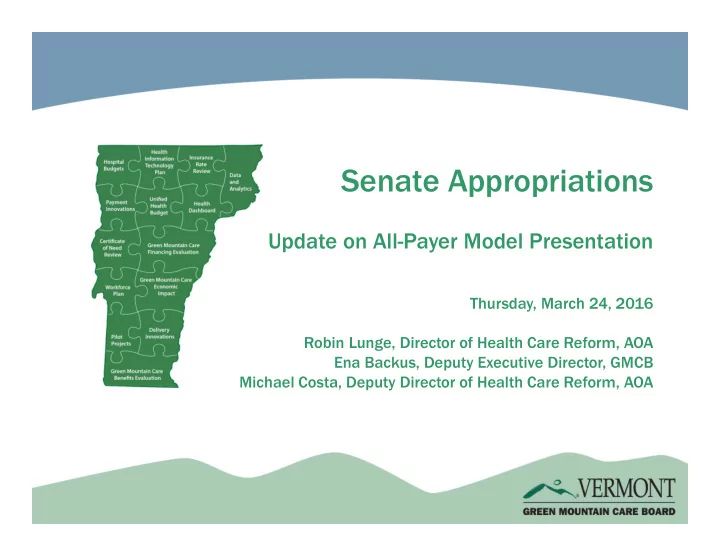

Senate Appropriations Update on All-Payer Model Presentation Thursday, March 24, 2016 Robin Lunge, Director of Health Care Reform, AOA Ena Backus, Deputy Executive Director, GMCB Michael Costa, Deputy Director of Health Care Reform, AOA
CMS Next Generation Payment Models Payment Model 1 Normal Fee For Service (FFS) Payments • CMS pays Next Gen participants FFS payments at standard payment levels • Risk Arrangement A • Shared risk at 80% (Performance Year 1-3) • Shared risk at 85% (Performance Years 4-5) • Savings/Losses capped at 15% • Risk Arrangement B • 100% Risk for Part A and B Services • Savings/Losses capped at 15% • Payment Model 2 Normal FFS Payment + Monthly Infrastructure Payments • Same as Model 1 with additional per beneficiary per month payment to support ACO • infrastructure costs The infrastructure payments are a loan that must be repaid following the performance • year either through savings achieved or direct payments from the ACO Risk Arrangements A and B same as Model 1 • 2
CMS Next Generation Payment Models Payment Model 3 Population-Based Payments (PBP) • • Next Gen participating providers submit claims to CMS as normal • CMS pays the providers reduced FFS payments and pays the ACO monthly payments that are an estimate of the total amount by which the provider FFS payments will be reduced • From the monthly payments from CMS, the ACO pays Next Gen participating providers according to written agreements that incorporate both value based payments (capitation and/or fixed revenue payments) and FFS payments • The ACO may apply different percentage reductions in payments to different subsets of participating providers • The amounts paid by the ACO to the providers may be reduced by a withhold to protect the ACO against financial risk • Risk Arrangements A and B same as Model 1 3
CMS Next Generation Payment Models Payment Model 4 All-Inclusive Population Based Payments • • Next Gen participating providers submit claims to CMS as normal • CMS receives encounter/claims information from the providers, but CMS pays the ACO a monthly Per Beneficiary Per Month (PBPM) payment based on the historical expenditures for care furnished to aligned beneficiaries of the Next Gen ACO and its participating providers (no CMS payments are made directly to the providers) • The ACO is responsible for paying Next Gen participating providers in accordance with written agreements that incorporate both value based payments (capitation and/or fixed revenue payments) and FFS payments • The amounts paid by the ACO to the providers may be reduced by a withhold to protect the ACO against financial risk • The ACO will receive claims and payment information from CMS to inform provider payments • Risk Arrangements A and B same as Model 1 4
CMS Next Generation Payment Models Savings/Loss Calculation • ACO savings/losses will be determined by comparing the ACO’s actual expenditures for Next Gen beneficiaries to a pre- established target • The risk arrangement (noted above) is then applied to determine the ACO’s share of savings or losses • Savings payments or loss recoupment will occur annually following a year- end financial reconciliation • ACOs will be required to have in place a financial guarantee (i.e. reserves or stop loss insurance) sufficient to cover potential losses 5
QUESTIONS 6
Recommend
More recommend